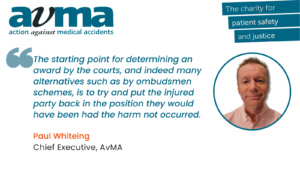The Hughes Report: the hidden trade-offs in no-fault compensation schemes

Estimated reading time: 4 minutes
Over the last few days, we have had the opportunity to finally see the outcome of The Times Health Commission’s ten recommendations to save the NHS alongside The Hughes Report on options for redress for those harmed by valproate and pelvic mesh. The timing of the publication of both reports within the same week is, I assume, just a coincidence, given what they both have to say about the wider landscape of clinical negligence and compensating those harmed by avoidable medical errors.
The Call for No-Blame Compensation: The Times Health Commission’s Stance
The Times Health Commission report recommends introducing a no-blame compensation scheme for medical errors with settlements determined according to need to ensure families get quick support and encourage the NHS to learn from mistakes. In reaching that conclusion, Rachel Sylvester, a Times journalist who chaired the Commission, is scathing about the failures that come with litigation. And whilst we at AvMA fully accept the many issues that come with litigation – which we do not readily advise people undertake as it is not for the faint-hearted – the Commission’s response lacked analysis of what any alternative would involve or why learning would improve. No-Fault Compensation is periodically held up as our saviour without any real debate about what it really would mean. But the Hughes Report sheds light on the realities.
Redress for Scheme for Pelvic Mesh and the Sodium Valproate Harmed Patients: The Huges Report
The Hughes Report is a substantial tome at just under 200 pages. For those who don’t know, this is the report from the Patient Safety Commission for England, Henrietta Hughes. The report sets out the views and options for providing redress for those harmed by pelvic mesh and the epilepsy drug Sodium Valproate and follows on from the report by Baroness Cumberledge’s First Do No Harm review, which provided a detailed assessment of the healthcare and regulatory failures, in both cases. So, in other words, another of the many healthcare scandals which we are becoming so used to in this country.
In reading the Hughes Report, which is comprehensive and detailed, I have sympathies with Henrietta Hughes as she clearly tries to put forward proposals to a Government which has acquired a track record in prevaricating over compensation victims for miscarriages of justice (witness the Post Office and Windrush scandals to name just two recent examples) and also knowing that that the public purse strings are tightly drawn, hence an interim payment recommended of just £25,000 which was at the low end of the average suggested by affected patients who answered the survey from the Commissioner.
Seeking Justice Beyond the Courts: the trade-off of redress schemes
However, where the Report gets interesting is what it has to say about the possible design of a Final Compensation Scheme which, sensibly and rightly, the Commissioner says must be a decision for the Government to decide. Here, it is worth quoting two paragraphs from the Report directly:
“296. We acknowledge that the quantification under the Main Scheme may result in awards less than court awarded damages and which, therefore, only represent a contribution towards the losses people have suffered.
297. But redress is different to compensation though litigation – and for good reason. By providing an easier, less stressful, and non-adversarial route for patients to access, such schemes do not try to match how a court would award financial.”
And there we have, across just those two paragraphs, the rub. We seemingly must choose between a court-based compensation model or a redress scheme that pays less. But why can’t patients have both? Why must they be short-changed in order to get the justice they deserve? There is no explanation provided for that choice, although implied in making that decision, the Commissioner has one eye on what the Government may be willing to foot in terms of a bill. And here I see the dilemma she faces.
It seems to me, in all of these debates about redress schemes and No-Fault Compensation and moving away from an adversarial scheme – all of which I fully accept has its downsides – we do not acknowledge the trade-off that will be made. Any scheme created to replace court-based compensation will provide a lesser form of compensation to those harmed. That cannot be right. The starting point for determining an award by the courts, and indeed many alternatives such as by ombudsmen schemes, is to try and put the injured party back in the position they would have been had the harm not occurred. In making that calculation, consideration must be given to a number of issues around compensating for financial losses and, harder to calculate, non-financial losses, such as pain and suffering, to name just two.
The UK Courts: A Benchmark for Justice
The UK courts are held up as a gold standard around the world for administering justice, so why, in our own backyard, do we now want to move away from it, or the principles that underpin it, to something else… unless the real aim of politicians who advocate such a path is to cut costs and save money. And, of course, it is interesting that right now, one of the keenest advocates for such a move is Jeremy Hunt, who, as Chancellor of the Exchequer, holds the public purse strings. Need I say more!
_________________________
Action against Medical Accidents (AvMA) is the UK’s leading patient safety and access to justice charity. We offer a range of services to patients and families impacted by avoidable medical harm. We are completely independent and rely on volunteers, fundraising and generous donations from supporters to enable us to help patients and bring about change. Find out more at www.avma.org.uk
Donate
You will also be helping us to give vital support to injured patients and to be a powerful voice for patients, patient safety and justice.
#PatientSafety #NHS #AccessToJustice


